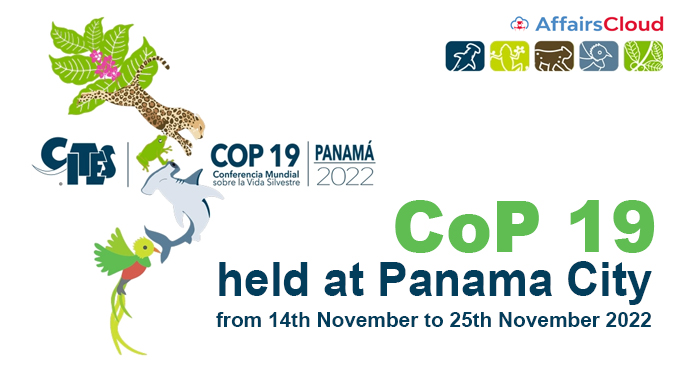 The 19th meeting of the Conference of the Parties(CoP19) to CITES (the Convention on International Trade in Endangered Species of Wild Fauna and Flora), also known as the 19th World Wildlife Conference took place from 14 to 25 November 2022 in Panama Convention Center, Panama City, Panama.
The 19th meeting of the Conference of the Parties(CoP19) to CITES (the Convention on International Trade in Endangered Species of Wild Fauna and Flora), also known as the 19th World Wildlife Conference took place from 14 to 25 November 2022 in Panama Convention Center, Panama City, Panama.
CoP19 of CITES is aimed at protecting various endangered Species by prohibiting the trade of these species.
About CoP19 to CITES:
Milciades Concepción, Minister of Environment of Panama, and Ivonne Higuero, Secretary-General of CITES signed the Host Country Agreement for CoP19 on 14th September 2021.
- This is the 4th meeting of the CoP to CITES held in Central and South America and the Caribbean since CITES came into force on 1 July 1975. This is also the first CoP held in the region since 2002.
Note: The CITES CoP convenes every 2 to 3 years to review the implementation of the CITES Convention.
Participants:
All 184 Parties to CITES have the right to participate in the CoP of CITES, also known as the World Wildlife Conference. They also have the right to put forward proposals for the Conference to consider, and to vote on all decisions.
Note:
So far 52 proposals which would affect the regulations on international trade of sharks, reptiles, hippos, songbirds, rhinos, 200 tree species, orchids, elephants, turtles and more were put forward at the CoP of CITES.
Highlights:
The Indian delegations led by Chandra Prakash Goyal, Director-General of Forests & Special Secretary(DGF&SS), Ministry of Environment, Forests & Climate Change(MoEF&CC) negotiated and deliberated on all the listed issues related to trade and conservation of endangered fauna and flora in CoP 19 of CITES.
India’s Proposal for Enhanced Protection of Leith’s Softshell Turtle
CoP19 to CITES has approved India’s proposal to transfer Leith’s Softshell Turtle (Nilssonia leithi) from Appendix II to Appendix I of CITES to ensure that legal international trade in the species does not take place for commercial purposes.
- The proposal was introduced by Chandra Prakash Goyal, DGF&SS, MoEF&CC.
About Leith’s Softshell Turtle:
Leith’s Softshell Turtle, endemic to peninsular India, is a large freshwater soft-shelled turtle which inhabits rivers and reservoirs.
The population of this species have declined by around 90% in the last 3 decades, due to illegal trade abroad for meat and illegal consumption within India.
It is classified as Critically Endangered by International Union for Conservation of Nature. (IUCN)
It is also listed on Schedule IV of the Wild Life (Protection) Act, 1972, which provides protection from hunting and trade.
India’s proposal to transfer Batagur kachuga from Appendix II to Appendix I of CITES:
During the CoP19 to CITES, India proposed to amend the appendices of the red-crowned roofed turtle (Batagur kachuga) and transfer it from Appendix II to Appendix I.
The proposal earned the support of the parties in CoP19 of CITES.
- The red-crowned roofed turtle is classified as critically endangered under the IUCN Red List.
- Threats: The list cites threats like habitat loss due to pollution and hydrological projects specific to the Gangal lowlands of northern India and Bangladesh.
Operation Turtshield:
India’s proposal for the induction of the freshwater turtle ‘Batagur kachuga’ earned the support of the parties in CoP 19 of CITES.
CITES appreciated the result achieved by Operation Turtshield by the Wildlife Crime Control Bureau to eliminate poaching and illegal trade of freshwater turtles.
India has proposed to protect a species of freshwater reptile called the red-crowned roofed turtle under the Convention on International Trade in Endangered Species (CITES)
The turtle which is native to India and Bangladesh is at a high risk of extinction.
Relief Provided to Indian Handicraft Exporter at CoP 19 CITES
During the CoP19 to CITES, India proposed to clarify the quantity of Dalbergia sissoo (Shisham) items like furniture and artefacts.
- During the meeting, it has been agreed that the Dalbergia sissoo timber-based items can be exported as a single consignment in a shipment without CITES permits if the weight of each individual item of this consignment is less than 10 kg.
- It also agreed that of each item only timber will be considered and any other item used in the product like metal and others will be ignored.
- The relief given in terms of the weight of each item will solve the issues of Indian artisans and the furniture industry and boost export.
Reason for the proposal:
Dalbergia sissoo is included in Appendix II of the CITES thereby required to follow CITES regulations for the trade of the species. At present, consignment weighing more than 10 kg requires CITES permits.
Due to this, exports of furniture and handicrafts made of Dalbergia sissoo from India have been falling from an estimated Rs 1000 crores per annum (~ 129 million USD) before the listing, to 500-600 crore Indian Rupees (~64 to 77 million USD) per annum after the listing.
Background:
17th meeting of the Conference of Parties (CoP) at Johannesburg, South Africa held in 2016, included all species of Genus Dalbergia in Appendix II of CITES.
In India, the species Dalbergia sissoo (North Indian Rosewood or Shisham) is found in abundance and is not treated as an endangered species.
CITES COP19 lists Sea Cucumbers as ‘Threatened’:
CoP19 to CITES has accepted the proposal to include sea cucumbers in Appendix II of CITES. The European Union, Seychelles and the United States proposed three species under Thelenota(genus of sea cucumber) to be included in Appendix II.
The CoP19 decided to include the genus Thelenota in the category, which classifies that the species is not facing the threat of extinction, however, the trade of the species must be regulated to avoid exploitation that will become incompatible with its survival.
- The proposal initiated by France was accepted with 97 votes in favour, 16 opposing it and 15 abstentions. The listing is expected to come into effect in the next 18 months.
- France stressed the need to protect sea cucumbers, citing their role in marine ecosystems. The role of Sea cucumbers on the seabed is very similar to the role of earthworms on land.
- The proposal was opposed by China, the largest market of Sea cucumbers, while the China Aquatic Products Processing Marketing Alliance proposed breeding projects to address the issue.
Note:
Wildlife Conservation Society-India (WCS-India) published an analysis in September 2022 which showed that sea cucumbers were the most frequently trafficked marine species in India from 2015-2021.
- Tamil Nadu, followed by Maharashtra, Lakshadweep and Karnataka recorded the highest number of marine wildlife seizures during this period.
WHO, FAO partners CITES COP19 to curb zoonotic diseases
CITES has recommended the consultation with parties like Convention on Biological Diversity and other relevant biodiversity-related agreements, the Food and Agriculture Organization of the United Nations (FAO), the World Health Organization (WHO) and the International Consortium on Combating Wildlife Crime to curb zoonotic diseases.
- COP19 to CITES concluded the draft decision on reducing the risks of future zoonotic diseases.
Aim: To identify possible emerging threats and reduce the risks of spreading pathogens, their spillover and transmission of zoonotic diseases through international wildlife trade supply chains.
- World Organisation for Animal Health, FAO, UNEP and WHO were invited to endorse the definition of the term zoonoses as “infectious diseases that can spread between animals and humans, can be spread by food, water, fomites or vectors.”
- The directives have been drawn against the backdrop of disease emergence associated with international wildlife trade.
Key Points:
i.The CoP19 to CITES is being asked to consider stricter trade regulations for nearly 600 species of animals and plants that are believed to be under increased threat of extinction from international trade.
ii.9 species are being recommended for less restrictive trade regulations and the proposals have been put forward by Parties to the CITES to review CoP19 in Panama.
iii.In the CITES COP19 agenda, the member countries have proposed to amend the appendices for wild animals, which include transferring hippopotamus, straw-headed bulbul, red-crowned roofed turtle and African elephant to Appendix I.
- The proposal to transfer Hippopotamus was made by Benin, Burkina Faso, the Central African Republic, Gabon, Guinea, Liberia, Mali, Niger, Senegal and Togo.
- Malaysia, Singapore and the United States have proposed the transfer of straw-headed bulbul (Pycnonotus zeylanicus) from Southeast Asia.
- Burkina Faso, Equatorial Guinea, Mali and Senegal demanded to consider African elephants for Appendix I.
Additional info:
i.The common hippopotamus, threatened with extinction, is listed as vulnerable in the IUCN Red List of Threatened Species in 2006.
ii.Straw-headed bulbul is listed as Critically Endangered in the IUCN Red List of Threatened Species in 2018.




